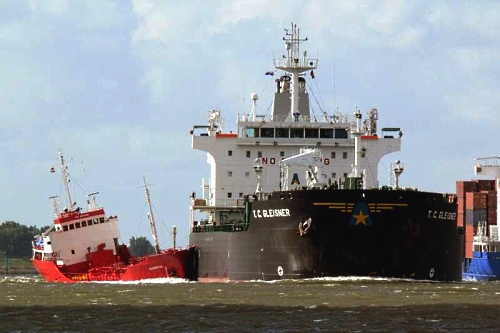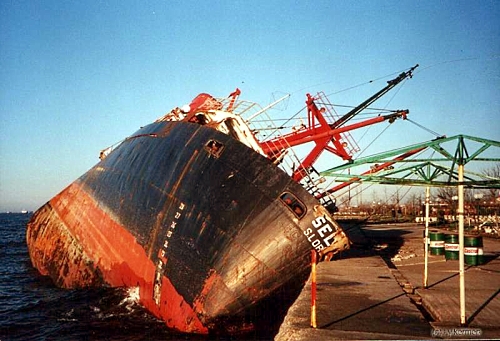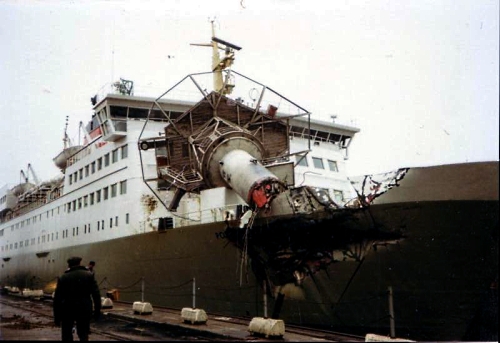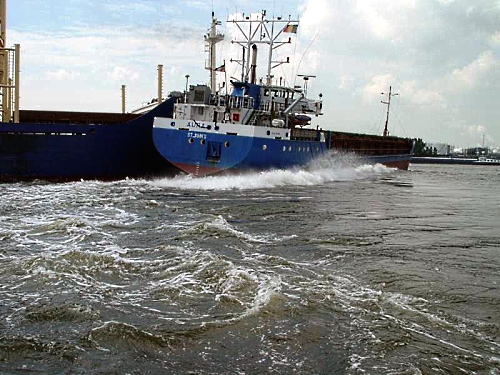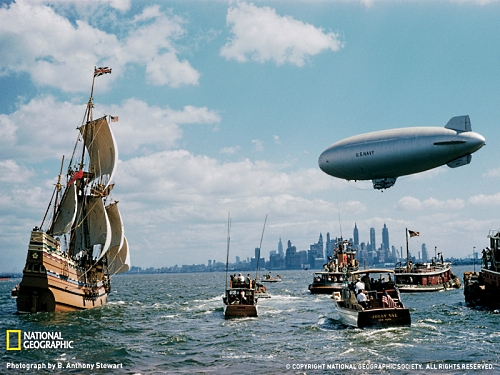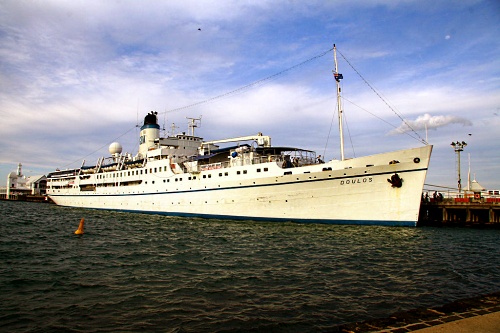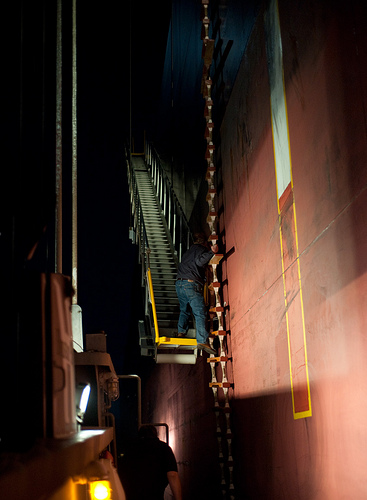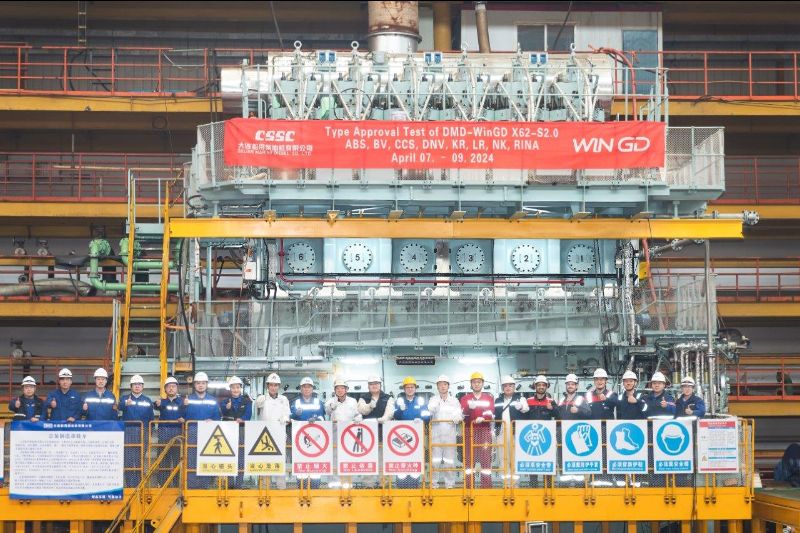Maritime Monday 190
The following is posted by Fred Fry:
Welcome to this 190th edition of Maritime Monday.
You can find Maritime Monday 140 here. (Published 15 December 2008)
You can find last week’s edition here.
—————————————-
This will be my last regular edition of Maritime Monday as the compiling author. I would like to thank you all for your attention as well as those who have submitted stories over the years. Like many others, I look forward to reading next week’s edition!
—————————————-
This Week’s Photos:
This week’s photos come from the website of Shipspotting:
Shipspotting.com is the worlds largest ship photo community with more than 700,000 images submitted by our members.
* T.C, Gleisner and Glennstar, by Wil Weijsters *
* PETROBRAS 36 – Sinking, by Steve Geronazzo *
* Povl Anker (and lighthouse Blenheim), by Foggy’s Grandmother *
* Coaster Aura being hit by Sea Bailo, by Alain Fierens *
Their homepage can be found here.
—————————————-
This Week’s Items:
EagleSpeak is on vacation. Be sure to check his homepage later on as he is sure to comment on the latest pirate news, which as of this morning includes the capture of the fully laden Greek-Flag VLCC tanker MARAN CENTAURUS.
gCaptain has “Dynamic Positioning 101- Heading alteration & speed“.
The Journal of Commerce has “Pirates Kill Ship’s Officer“. Why do you arm merchant ships? Because there is not enough naval vessels in the world to protect merchant seamen everywhere. This happened off Western Africa. Somalia is off Eastern Africa.
The pirates shot and killed the chief officer, or second in command, of the Monrovia-flagged Cancale Star when he confronted them in the early morning hours of Nov. 24 approximately 18 nautical miles from the coast of Benin, the ship’s owners Chemikalien Seetransport said in a statement.
War is Boring has “Regaining the Initiative against Somali Pirates“.
“There’s a sense that pirates are getting oceanographically smarter,” analyst Martin Murphy said last year. Indeed, pirates have the advantage of initiative: they know where warships are concentrated, and can attack elsewhere, as long as they have the motherships and intelligence to enable long-distance operations.
Tims Times is back at sea and it is rough in “Roll on next port“.
HAWSEPIPER: The Longest Climb gives ammunition to the international claim that Americans are just plain dumb when he does not recognize that he is being asked to participate in bunker oil fraud in “Really?” Instead of worrying about America’s reputation in the world, perhaps a little more time should be spent evaluating what a sorry state much of the world is in.
After an hour of waiting, screaming, and throwing bolts at the house on the ship, I pass the buck, and have the ship’s agent call the captain. 2 minutes later, the engineer comes out. He refuses to give me the paperwork. “Forget the paperwork,” he says. “I give you new paperwork.” He is pinching his thumb and forefinger together. No shit, the guy probably wanted to give me a thousand bucks or so for about $50,000 worth of oil. I ignore him. The guy then loses his ability to speak English, mysteriously. I reasonably ask him to be ‘a goddam professional here,’ and he responds by walking away. I am alone again.
BarentsObserver has “Admiral: Russia will have no long-ranging vessels left after 2015“. Seems that they have just not planned for the massive requirements to replace their fleet.
National Geographic has their archive photo “Mayflower II, New York Harbor“, by B. Anthony Stewart.
Sail-World has a project that seems to not take into account certain factors about the environmental qualities of shipping with “Greenheart appeal – make the Greenship dream a reality“.
The longer vision is to provide needy coastal communities around the world with an affordable means of transport. They see that such ships could help impoverished coastal and island regions improve their standards of living, while preserving their traditions and protecting the environment.
The vessel they have in mind is a solar- and wind-powered cargo sailing ship which will be able to sail around the world, completely independent of fossil fuels, visiting both developed and developing countries on a multiple mission of sustainable development and environmental protection. A secondary mission is to represent fair trade and, of course, education.
The Greenheart project is currently focused on the bottom line, fundraising with an ambitious goal of having their first ship in the water by the end of 2010.
There are some ‘green’ aspects of shipping that seem to be ignored as they do not fit the narrative. First, today’s large ships each replace tens of smaller vessels. Today’s power plants are more efficient and ships are designed to be more economical in general. Then there is the issue of the reduced emissions and other pollution prevented by sending cargo by sea instead of by road, rail or air.
Save the National Lighthouse Museum dies: “National Lighthouse Museum Board Disbands, Staten Island misses the boat to host and become a national tourist capital for lighthouse lovers and U.S. Coast Guard Veterans.” At least we still have the great lighthouse museum in Maine.
Perhaps if the NYC’s Economic Development Corporation as well as Borough politicians insisted that they open a bare bones museum and gave them access to the site and historic buildings as well as worked with the museum in the initial years to secure and maintain the pier, the Landmark Nantucket LV 112 Lightship would still be there and the museum would have slowly grew a significant collection of artifacts and could have already attracted millions of tourists to the site, this would of enabled the museum to grow financially secure, as well as permitted them to apply for grants to repair the historic buildings as well as offer increased educational programming to visitors. By opening and operating and being able to accept admission fees and sell souvenirs and concessions the magnificent multimillion dollar museum plan would of been a future reality instead of a flickering dream. Unfortunately the course taken did not lead to a safe harbor for this irreplaceable monument to our nations maritime heritage but to a treacherous rocky shore where the museum plans crashed and sank against the waves of speculative real estate development.
OM Ships International has “Sudden end for Doulos“. (Official Press Release here) Take a virtual tour of the ship here.
Doulos personnel and partners around the world are coming to terms with the news that the ship’s service will end on 31st December 2009. Until this week, the crew had hoped the world’s oldest ocean-going passenger ship could continue sailing until September 2010. But surveys by marine safety authorities confirmed major repairs are required to keep Doulos in service. Early estimates indicated this work would cost over €10 million.
—————————————-
BarentsObserver has “Murmansk port and Sovcomflot on privatisation list“. Of course any buyer risks the possibility that the Russian Government can seize the company (or owner) if they ever feel the need to steal the company back (or punish the owner).
Of more interest, however, is probably the government’s plan to sell its 25 percent share in Sovcomflot, Russia’s by far largest shipping company. The company had a profit of $406 million (€272 million) in 2008.
Deep Water Writing knows what he wants for Christmas.
So it is not with too much surprise that the second edition of Jack Tar Magazine’s Sexy Girls of Maritime Calendar is at the top of my wish list for Christmas. Featuring twelve pages of the West Coast’s “Sexy, strong and accomplished women who live, play and work on boats” it is the ideal gift for a lonely sailor at sea.
Casco Bay Boaters Blog has news that the US has at least two towns with nothing better to do that to see how high they can stack lobster pots in “The 200 Pot Rockland Tree Is Up“.
US Naval Institute Blog has an interview with US-based the owner of Nexus Consulting Group, a firm that specializes in placing armed teams on cargo ships in “RPG’s vs fire hoses: place your bets“.
Salamander: There are a lot of questions out there about arming merchant ships, with the two sides arguing if it is a good idea or a bad idea. There is a large difference of opinion and perspective between what you do and what many European and international organizations feel is the right path to take when it comes to keeping merchant ships away from predation by pirates. Why do you think they have the view that they have?
Doherty: I have to question what their agenda really is. Just this week we have the example of Somali pirates using deadly force. They shot and killed the Captain on one of the vessels. They are using deadly force to terrorize merchant mariners transiting the Gulf of Aden, who are just exercising innocent passage – trying to do their job.
The people who say, “Let’s not use weapons. Let’s not go there yet.” I question their agenda. I think a lot of that attitude comes from the fact that a lot of these organizations and a lot of those people who are supporting that stance are in the United Kingdom.
As I mentioned earlier, I used to be Special Agent Kevin Doherty. In my work, I used to travel through the UK. Even then, on official business with a diplomatic passport, I was not allowed to bring my firearm into the UK. They have some of the strictest firearms laws in the world, and you look that the IMO and you look at the shipping companies and you look at the insurers, they are mostly based in the UK.
You really have to question the agenda of those who know clearly that the Somalis are using deadly force, from AK-47s to RPGs. They are saying, “Don’t arm yourself against that.”
“What is your agenda?” That is my question.
Salamander: Having spent some time in the UK, and worked with the British military, I am very familiar with trying to deal with the point of view that they have.
Doherty: The thing is, they are not saying that we shouldn’t; they are saying that we can’t. They want us to maintain their standards – because they can’t maintain ours. I don’t understand how people can say, “Kevin, you can’t put weapons on ships, you escalate the situation.”
How much higher can I escalate? The pirates are already using deadly force. They are firing RPGs.
Go read the whole thing. I also had a chance to talk with Mr. Doherty and during our discussion he made the point that by limiting your defensive options you are essentially ceding ground to the pirates. And since the pirates are potentially armed with RPGs, the initial goal should be to keep them at least as far away from your ship as the range of an RPG, which he does discuss further down in this article.
Lloyd’s List has the European view in “Use of private guards in pirate waters is not an option“, an opinion piece by Per Gullestrup, the chief executive of Clipper Group.
Use of private guards to secure crew and vessel in pirate waters is, in our view, not an option. Previous cases of piracy have shown that use of force (ultimately deadly) may be required to prevent hijackings. Even if anyone has the right to self defence, the legal implications if a private person ends up using deadly force against a suspected pirate are very diffuse. The legal framework to effectively support use of force engaged by private guards does simply not exist. Not only do subjects like rules of engagement and line of command onboard the vessel give rise to many uncertainties, but even worse, the captain and crew are likely to get actively involved in use of force. Seafarers are not soldiers — and they should not be made to be, either.
Instead, security should be established by government agencies and organisations which — under international law — are entitled to the use of force in order to establish a secure environment and to secure sea lanes.
Clipper has on average one to two vessels passing through Gulf of Aden or in the Indian Ocean along the east coast of Somalia on a weekly basis. Approximately 75% of the transits have been conducted in highly appreciated convoys offered by a number of navies present in the Gulf of Aden. The remaining 25% have utilised the Group Transit System established by the European Union.
Mr. Gullestrup’s company paid a ransom to Somali pirates in January to free their vessel the CEC FUTURE. Personally, I think that is the bigger sin than any mistake armed guards or seafarers might make defending their ship. Given that it will be impossible to have Navy protection everywhere, I think the final solution will be a combination of armed professional and private forces employed in pirate hotspots as well as arms on ships for seafarer use in other areas, just in case.
US Naval Institute Blog also looks at AIS in “Open Source Intelligence For Armchair Admirals“. One question is whether this information should be out there.
MarineBuzz has “Indian Navy: First of Project 11356 Stealth Frigates to be Floated by Yantar Shipyard Russia“.
Tugster has photos: “Thanksgiving Mysteries“. Answers here.
NY TUGMASTER’S WEBLOG talks about spending “The Holidays Afloat” away from home.
Indigenous Boats has great photos: “Canadian Canoe Museum – Awe Inspiring“.
Information Dissemination has “More on Sea Fighter“.
SHIPS & THE SEA has “SHIP PHOTOGRAPHS“.
I have been photographing ships since 1970 although my first good quality camera was obtained only in 1975. Since then I have been able to make about half a million photographs of ships, and ships have always been the first reason behind my drive into serious photography. This because first of all I have always been a shipping enthusiast. It all started with a colection of post cards of ships, later I also added brochures and all informative items including books. Photography allowed me a new dimension to my shipping interests and so I have been photographing all kinds of ships in many different corners of the world, always based in Lisbon.
Hellenic Shipping News has “Swedish minister tell shipping to cut emissions by 20%“. One way to meet the reduction of course would be to re-flag…
Kennebec Captain has ““Filipino Monkey” is an Ethnic Slur“.
The Merchant Marine Express has “Being Thankful“.
What we do today, is a stepping stone to something higher (and possibly better) on the ladder for superior living. Family, friends, or both should have something to do with it.
Keep a positive outlook and give thanks to those around you or who influence your life.
Wikipedia has the final voyage of Stalin’s Gulag fleet ship “SS Indigirka“.
Final voyage
On December 8, 1939 the Indigirka left Magadan to return to Vladivostok under Captain Nikolai Lavrentevich Lapshin. It contained 39 crew, 249 fishermen and their families, 50 prisoners under guard, and 835 prisoners with technical skills who had been released to work for the war effort. On December 13, 1939 at 2:20 AM (other reports place the event on December 12, 1939) the ship ran aground in a blizzard off the Japanese coast near Sarufutsu while trying to enter the La Perouse Strait. As the ship turned over, the guards prevented the escape of the prisoners from the holds, and the ship came to rest in shallow water on its side. The Japanese rescued the captain and most of the crew, guards, and fishermen, but it took three days for any rescue of the trapped prisoners to begin. December 16, when the Japanese rescue team then opened the hull with acetylene torches, only 28 survivors (one of whom later died) were found among more than 700 dead prisoners. Overall 741 people perished. According to Sergey Korolyov’s oral statements, he “missed” the Indigirka convoy and was sent from Kolyma to Vladivostok on the next ship on December 23.Captain Lapshin was tried and executed for abandoning the ship; chief of NKVD convoy who locked the prisoners in a sinking ship was sentenced to eight years. A cenotaph at Sarufutsu commemorates the tragic end of the Indigirka.
—————————————-
Helsingin Sanomat has “Silja Europa’s rudder failure affects thousands of passengers“.
Bryant’s Maritime Blog has “IMO – France signs Recycling Convention“.
The IMO issued a news release stating that France has become the first country to sign, subject to ratification, the Hong Kong International Convention for the Safe an Environmentally Sound Recycling of Ships, 2009. The Convention will enter into force 24 months after the date on which 15 States, representing 40% of world merchant shipping by weight, have accepted the Convention. Furthermore, the combined maximum annual ship recycling volume of those States must, during the preceding 10 years, constitute not less than 3% of their combined merchant shipping tonnage. (11/23/09).
Houston ship Pilot/photographer OneEighteen has “The Ladder“.
This photo symbolizes a lot about the unknowns of piloting; beginning with whether the thing is tied off OK or not. Four U.S. pilots lost their lives in pilot ladder accidents last year.
Beyond that there are the issues of being woken up in the middle of the night to board a strange ship with an unknown crew. The darkness at the head of the ladder sums it up well.
A study done for the cruise ship industry in Florida tries to compare ship pilots to air traffic controllers in job tension. I really don’t think so.
HollandAmericaBlog has “Goodbye After 36 Years“.
After 36 years of loyal service with HAL, chief housekeeper Pak Soeparno is retiring. Soerparno holds the record for the longest-serving chief housekeeper from Indonesia. He has been a valuable employee for the company, having worked on almost all the ships in the HAL fleet.
The New York Times has “Tuna’s Death Spiral“.
The United States recommended what it hoped would be an acceptable interim compromise of 8,000 tons or lower. But American negotiators were outgunned by the Japanese — where bluefin tuna is the source of high-grade sushi — and by the European Union, whose politicians do pretty much what the big commercial fleets in France, Spain, Italy and other Mediterranean countries tell them to do and who apparently won’t really start worrying until the last fish has been caught.
There is only one honorable course left for the United States. That is to join with Monaco and other countries that have proposed listing the bluefin as an endangered species under an international law known as the Convention on International Trade in Endangered Species. The law effectively bars commercial trade in any listed species, and has been helpful in protecting other animals like elephants and whales.
Maybe the scientists trying to save the tuna should link our salvation from Global warming to the saving of the tuna…
Funeral Wise has “World’s longest funeral, on a cramped cargo ship in the middle of the Pacific“.
Buenos Aires Herald has “Gov’ts more welcoming than in Europe – African immigrants drift toward Latin America“.
Stowed away on cargo ships and unsure where their dangerous journeys will take them, increasing numbers of African immigrants are arriving in Latin America as European countries tighten border controls.
Some head to Mexico and Guatemala as a stepping stone to the United States, others land in the ports of Argentina and Brazil. Though many arrive in Latin America by chance, once in the region they find governments that are more welcoming than in Europe.
“One night I went to the seaport. I was thinking I was going to Europe. Later I found out I was in Argentina,” said Sierra Leone immigrant Ibrahim Abdoul Rahman, a former child soldier who said he escaped his country’s civil war by sneaking onto a cargo ship for a 35-day voyage.
nbc15 has “Unsung Hero: DeForest Man Survives Hellish Night at Sea – Sailor Kept Horrifying Memories to Himself Until Recently“.
Gunner’s Mate Julius Bellin was serving in the U.S. Navy’s Armed Guard, protecting the cargo Ship John A. Johnson, when a Japanese submarine torpedoed the ship between San Francisco and Hawaii. “It’s an awful feeling to know you have to abandon your ship, and you’re losing your home. And then you’re at the mercy of the sea.”
While Julius frantically tried to pull some of his crew mates to a life raft, the submarine attacked again. “We were on the life raft, and they machine gunned us, they rammed us, they damaged the life raft. But it still held up. My friend, I tried to pull him on the life raft, and we were covered with oil, and he slipped out of my hands, and he got chopped up by the submarine propellers. And that memory stayed with me for quite some time, because I often wondered if I could have done something to save him.”
sfexaminer has “Bar pilots might be unfit for duty“.
Reuters has a current list: “Ships held by Somali pirates“.
Cinema Blend has the upcoming moving on the salvage of the COUGAR ACE in “Invictus Writer Will Dive Into Deep Sea Cowboys“. (See Wired‘s story “High Tech Cowboys of the Deep Seas: The Race to Save the Cougar Ace” which is the inspiration for the movie.)
The New York Times also has “Catching Tuna and Hanging On for the Ride“.
Apparently, it never occurred to the authorities that someone might be crazy enough to want to catch a bluefin while sitting in what amounts to a floating plastic chair and enjoying what Melville called a “Nantucket sleigh ride.”
Since the end of July, Lamoureux has caught three bluefins this way, paddling a couple of miles off Race Point, at the tip of Provincetown, hooking a tuna and holding on, the rod clipped to a harness on his chest, while being towed at speeds up to 15 miles an hour before the fish exhausts itself.
Mother Nature Network has “Sushi fraud: When “tuna” isn’t tuna“.
DiverNet has “Minister questions Sea Shepherd link” and Dutch News has “Anti-whaling ship can remain Dutch“. Might this lead to discrimination against Dutch-Flag vessels in Japan? The Japanese can make life difficult if they want to without even appearing that they are doing it on purpose. (On a slightly related note, the Japanese dolphin-killing documentary, The Cove, is now available for pre-ordering at Amazon)
io9 has “Navy-Trained Sea Lions Ready to Arrest Enemy Divers“.
BitterEnd Blog has an OASIS OF THE SEAS PHOTO: “Even the lifeboats are huge“.
intheboatshed.net has video: “Rowing in Venice is under threat – pass the message on!“
euobserver has the ongoing stupidity with “Nordic countries irked by continued EU fish dumping“.
While discarding fish has been illegal in Iceland, Norway and the Faeroe Islands since the 1990s, boats in the European Union are obliged to discard their fish if they catch the wrong fish or if the fish do not measure up size.
European Union quotas strictly limit the amount of fish that ships can bring back to port, but there is no restriction on the amount of fish they can catch. Last year, the EU estimated that between 40 and 60 percent of all fish caught by trawlers in the North Sea was discarded.
The Old Salt Blog has a MAERSK ALABAMA update in “Former crew members sue US shipping firm over hijacking“.
The Old Salt Blog also has “Free Aircraft Carrier – ex USS John F Kennedy Available for Donation to Appropriate Group“.
Popular Mechanics has “Test Drive in the World’s Fastest Personal Submarine“. (Found via Instapundit)
Danger Room has “Navy’s ‘Affordable’ Shoreline Ship: $477 Million Overbudget“.
The Misunderstood Mariner explains “Lines In The Sea“.
Plan Philly has story and photos of the SS UNITED STATES in “They will not abandon the Big U“.
Molten Eagle has yet another sub malfunction for Russia in “One sentence, many submarine questions” and “Russian Sub Alrosa Pending (or not) Updates“.
Notes From the Wooden and Iron World has “A Tale of Two Figureheads“.
Originally built in Scotland in 1878, the Falls of Clyde was under a full restoration project in Honolulu for the Bishop Museum when in 1974 Whitehead was given the job of replacing the original carving. A massive 8ft high, it weighed over a ton and a half. Ever the perfectionist, Whitehead flew out to supervise the fitting of the ‘White Lady’, possibly the first time a carving of this size had been fitted on a vessel in over 100 years.
Mr. Boat Blog has video: “Sewage surfing.“
Financial Times has “Fishermen urge EU to end dumping“.
ShipGaz News has “Largest giant avoids scrapyard“. See Wikipedia for more on the ship here.
The largest cargo vessel ever built has at least for the time being avoided its final fate at the scrappers. Fred Olsen Production has sold its FPSO Knock Nevis to a Malysian bunkering company, which will use the 564,000 DWT giant vessel as a hub for its activities.
YouTube has parking at the shipbreaking yard in “ship accident“.
—————————————-
Fairplay Daily News has:
Pirate route legality questioned – THE ITF warned today that shipowners and flag states that allow vessels to pass through pirate-hazard waters might be acting illegally.
The International Transport Workers’ Federation said: “The risk of attack is now so great that putting seafarers in harm’s way amounts to a breach of the shipowner’s duty of care.”
The ITF argued that ships should be allowed to travel through the Gulf of Aden, off the coast of Somalia and through parts of the wider Indian Ocean only if they have naval protection or are classified as low risk.
“Many of the world’s largest ship registers have provided not one vessel to patrol an ocean that can only be made safe by an increase in the number of warships needed to aggressively patrol and police it,” ITF maritime co-ordinator Steve Cotton said.
The federation also repeated its position that seafarers should not be armed to deal with pirates because that would spark an escalation of violence. – Fairplay Homepage (Used with Permission)
AND:
Low-sulphur fuel delay seen – DNV HAS warned that there is “no way” that ships will be burning low-sulphur fuel by 1 January, as required under an EU directive.
The Norwegian class society’s environment chief Eirik Nyhus told a Hamburg conference yesterday that shipping has been slow to retrofit vessels and that changing fuels now pose a risk in terms of boiler safety.
It is also not yet to Det Norske Veritas clear how strict the enforcement of the directive will be. “We don’t know what will happen over the next few months,” he warned.
Nylus expressed hope that the priority of member countries when inspecting vessels will be “safety first”. – Fairplay Homepage (Used with Permission)
—————————————-
Submissions for future editions:
Please submit articles for inclusion in next week’s edition using the following submit form at Blog Carnival. You are also welcome to email stories and photos to [email protected] for inclusion in future editions as well as suggest areas of coverage.
—————————————-
Previous Editions: As linked below or click on the tag ‘Maritime Monday’ for all gCaptain editions.
1 – 2 – 3 – 4 – 5 – 6 – 7 – 8 – 9 – 10 – 11 – 12 – 13 – 14 – 15 – 16 – 17 – 18 – 19 – 20 – 21 – 22 – 23 – 24 – 25 – 26 – 27 – 28 – 29 – 30 – 31 – 32 – 33 – 34 – 35 – 36 – 37 – 38 – 39 – 40 – 41 – 42 – 43 – 44 – 45 – 46 – 47 – 48 – 49 – 50 – 51 – 52 – 53 – 54 – 55 – 56 – 57 – 58 – 59 – 60 – 61 – 62 – 63 – 64 – 65 – 66 – 67 – 68 – 69 – 70 – 71 – 72 – 73 – 74 – 75 – 76 – 77 – 78 – 79 – 80 – 81 – 82 – 83 – 84 – 85 – 86 – 87 – 88 – 89 – 90 – 91 – 92 – 93 – 94 – 95 – 96 – 97 – 98 – gCaptain Editions: 99 – 100 – 101 – 102 – 103 – 104 – 105 – 106 – 107 – 108 – 109 – 110 – 111 – 112 – 113 – 114 – 115 – 116 – 117 – 118 – 119 – 120 – 121 – 122 – 123 – 123a – 124 – 125 – 126 –127 – 128 – 129 – 130 – 131 – 132 – 133 – 134 – 135 – 136 – 137 – 138 – 139 – 140 – 141 – 142 – 143 – 144 – 145 – 146 – 147 – 148 – 149 – 150 – 151 – 152 – 153 – 154 – 155 – 156 – 157 – 158 – 159 – 160 – 161 – 162 – 163 – 164 – 165 – 166 – 167 – 168 – 169 – 170 – 171 – 172 – 173 – 174 – 175 – 176 – 177 – 178 – 179 – 180 – 181 – 182 – 183 – 184 – 185 – 186 – 187 – 188 – 189 – 190 – 191
—————————————-

Subscribe for Daily Maritime Insights
Sign up for gCaptain’s newsletter and never miss an update
— trusted by our 109,120 members

Get The Industry’s Go-To News
Subscribe to gCaptain Daily and stay informed with the latest global maritime and offshore news

 Join The Club
Join The Club



